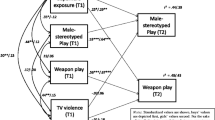Abstract
This study was designed to determine the relationship between the amount of time children spend watching television and their knowledge of adult sex-role stereotypes. Males and females in grades 1, 3, 5, and 7 who were classified as heavy television viewers (25 or more hours per week) or light viewers (10 or less hours per week) both at the time of the study and 15 months previously were administered the Sex Stereotype Measure, an instrument designed to determine children's awareness of stereotyped sex-role perceptions held by adults. Heavy viewers were found to have more stereotyped perceptions than light viewers. A significant interaction effect indicated that among low viewers the perception of male stereotypes steadily declines with increasing age; among heavy viewers, stereotypic responses to male items are maintained with increasing age. No comparable interaction effect was obtained for perception of female stereotypes. The role of interaction with live models in breaking down stereotypic perceptions of males is discussed.
Similar content being viewed by others
References
Atkin, C. K., & Miller, M. M. Experimental effects of television advertising on children. Paper presented at the meeting of the International Communication Association, Chicago, April 1975.
Bandura, A. Social-learning theory of identificatory processes. In D. A. Goslin (Ed.), Handbook of socialization theory and research. Chicago: Rand McNally, 1969. Pp. 213–262.
Beuf, A. Doctor, lawyer, household drudge. Journal of Communication, 1974, 24, 142–145.
Brown, D. G. Sex-role preference in young children. Psychological Monographs, 1956, 70(14, Whole No. 42).
Busby, L. J. Sex roles as presented in commercial network television programs directed toward children: Rationale and analysis. Unpublished doctoral dissertation, University of Michigan, 1974.
Courtney, A. E. & Whipple, T. W. Women in TV commercials. Journal of Communication, 1974, 24, 110–118.
DeFluer, M. Occupational roles as portrayed on television. Public Opinion Quarterly, 1964, 25, 54–74.
Dominick, J., & Rauch, G. E. The image of women in TV commercials. Journal of Broadcasting, 1972, 16, 259–265.
Frueh, T., & McGhee, P. E. Traditional sex role development and amount of time spent watching television. Developmental Psychology, 1975, 11, 109.
Gerbner, G. Violence in television drama: Trends and symbolic functions. In G. A. Comstock & E. A. Rubinstein (Eds.), Television and social behavior. Vol. 1. Media content and control. Washington, D.C.: U.S. Government Printing Office, 1972. Pp. 28–187.
Katzman, N. Television soap operas: What's been going on anyhow? Public Opinion Quarterly, 1972, 35, 200–212.
Kohlberg, L. A cognitive-developmental analysis of children's sex role concepts and attitudes. In E. E. Maccoby (Ed.), The development of sex differences. Stanford: Stanford University Press, 1966.
Maccoby, E. E., & Wilson, W. C. Identification and observation learning from films. Journal of Abnormal and Social Psychology, 1957, 55, 76–87.
Maccoby, E. E., Wilson, W. C., & Burton, R. V. Differential movie viewing behavior of male and female viewers. Journal of Personality, 1958, 26, 259–267.
Mischel, W. Sex-typing and socialization. In P. H. Mussen (Ed.), Carmichael's manual of child psychology (Vol. 2). New York: Wiley, 1970. Pp. 3–72.
Seggar, J. F., & Wheeler, P. World of work on TV: Ethnic and sex representations in TV drama. Journal of Broadcasting, 1973, 19, 201–214.
Stein, A. H., & Friedrich, L. K. Impact of television on children and youth. In E. M. Hetherington (Ed.), Review of Child Development Research (Vol. 5). Chicago: University of Chicago Press, 1975.
Sternglanz, S. H., & Serbin, L. A. Sex role stereotyping in children's television programs. Developmental Psychology, 1974, 10, 710–715.
Streicher, H. W. The girls in the cartoons. Journal of Communication, 1974, 24, 125–129.
Tedesco, N. S. Patterns in prime time. Journal of Communication, 1974, 15, 55–64.
Williams, J. E., & Bennett, S. M. The definition of sex stereotypes via the Adjective Check List. Sex Roles, 1975, 1, 327–337.
Williams, J. E., Bennett, S. M., & Best, D. L. Awareness and expression of sex stereotypes in young children. Developmental Psychology, 1975, 11, 635–642.
Author information
Authors and Affiliations
Rights and permissions
About this article
Cite this article
McGhee, P.E., Frueh, T. Television viewing and the learning of sex-role stereotypes. Sex Roles 6, 179–188 (1980). https://doi.org/10.1007/BF00287341
Issue Date:
DOI: https://doi.org/10.1007/BF00287341




